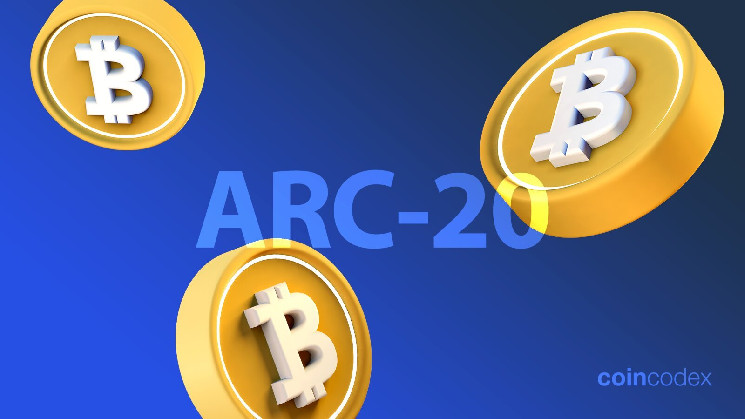ARC-20 is a token normal that makes it attainable to create fungible tokens that may be held and transferred on the Bitcoin blockchain. ARC-20 normal tokens are issued utilizing the Atomicals protocol. Within the ARC-20 normal, tokens are represented with satoshis, that are the native unit of the Bitcoin blockchain (1 BTC consists of 100 million satoshis).
ARC-20 is a fungible token normal for Bitcoin
The idea of fungible tokens was popularized within the cryptocurrency area by Ethereum, the place they’re usually issued utilizing the ERC-20 normal. Sure ERC-20 tokens have achieved huge market capitalizations – among the largest fungible tokens in the marketplace in the present day embody UNI, SHIB, LDO, and, after all, stablecoins.
The power to mint fungible tokens is on the market on virtually each blockchain platform that has general-purpose good contracts. For instance, there are fungible tokens on Solana (SLP tokens), BNB Chain (BEP-20 tokens), Cardano (native tokens), and so forth.
Whereas Bitcoin’s good contracts functionality is much more restricted, builders have give you inventive methods to symbolize several types of digital belongings (fungible and non-fungible tokens) on the Bitcoin blockchain.
The ARC-20 token normal is enabled by the Atomicals Protocol, which is a option to create each fungible and non-fungible tokens on Bitcoin. The Atomicals crew refers back to the digital belongings that may be created by way of the protocol as “digital objects”.
Minting ARC-20 tokens
Anybody can create an ARC-20 token and decide its provide, ticker and metadata (for instance official web site, social media hyperlinks and a picture). Nonetheless, since every ARC-20 token is represented by 1 satoshi, there’s truly a pracitcal restrict to what number of ARC-20 tokens somebody can mint.
That is completely different from the ERC-20 normal for instance, the place you can also make a token’s provide as huge as you need for no further value whilst you’re creating it. For instance, many meme cash issued on blockchains corresponding to Ethereum have a provide of lots of of trillions of tokens.
The method of minting ARC-20 tokens and its implications on token provide are arguably probably the most distinctive side of ARC-20 tokens when in comparison with different fungible token requirements in use in the present day, so let’s clarify it in a bit extra element.
Decentralized ARC-20 token minting
The decentralized ARC-20 token minting mode permits the creator of the token to specify what number of mints of the token are allowed, and what number of tokens are issued in a single mint. By itself, this doesn’t create any tokens, however customers who need the token can mint them.
Direct ARC-20 token minting
Within the direct minting mode, the person creating the ARC-20 token creates an output that incorporates the whole provide the token. For instance, if you wish to create a token with a provide of 10 million with the direct minting mode, you’ll want to create an output of 10 million satoshis (0.1 BTC). The extra tokens you wish to mint, the extra BTC you’ll want to present.
Methods to use ARC-20 tokens?
So as to maintain and transact with ARC-20 tokens, you want a Bitcoin pockets that helps UTXO choice, also referred to as “coin management”. Listed below are just a few examples of such wallets:
- Sparrow
- Electrum
- Mycelium
- Blue Pockets
- Ledger Reside
ARC-20 vs. BRC-20 – Atomicals and ordinals in contrast
ARC-20 tokens carry out an analogous perform to BRC-20 tokens, that are additionally fungible tokens on the Bitcoin community, besides they’re issued by way of the Ordinals protocol.
Though Atomicals and Ordinals present very related utility, the 2 protocols do differ in some areas. Notably, Ordinals should be used with Taproot addresses for all use circumstances. Atomicals require the usage of Taproot addresses for minting and updating belongings, however not for transferring them.
Fungible tokens should not supported within the base Ordinals protocol, whereas Atomicals implement them because the first-class ARC-20 normal. The Atomicals protocol additionally helps two distinct varieties of minting fungible tokens.
One other distinction is that Ordinals doesn’t have a reputation service within the base protocol. In the meantime, Atomicals encompasses a identify service which is applied by way of first-class NFTs known as Realms.
To sum up, we will say that the Atomicals protocol affords a broader characteristic set than Ordinals, however the Ordinals protocol has seen extra adoption to date. To be honest, the Ordinals protocol has benefited from a head begin, because it was launched in January of 2023, whereas the Atomicals protocol was launched in September of 2023.
In the intervening time, the Ordinals protocol is much more well-liked than the Atomicals protocol, though Atomicals have been gaining some traction. In whole, Atomicals protocol transaction have generated round 274 BTC in charges, whereas Ordinals protocol transactions have generated 4,050 BTC in charges.
If you wish to see a comparability between Ordinals and Atomicals based mostly on on-chain exercise, you possibly can take a look at this beneficial Dune Analytics dashboard that compares the 2 protocols.
The underside line
ARC-20 tokens are fungible tokens issued on the Bitcoin blockchain utilizing the Atomicals Protocol. When ARC-20 tokens are minted, every token is represented with a satoshi, which is the smallest unit of BTC.
By way of performance, ARC-20 tokens are pretty much like BRC-20 tokens, that are issued utilizing the Ordinals protocol. At present, the Ordinals protocol is extra well-liked than the Atomicals protocol, however the Atomicals protocol gives some additional options which might assist it achieve extra adoption.
If you wish to be taught extra about Bitcoin, check out our article explaining how Bitcoin pockets addresses work.







